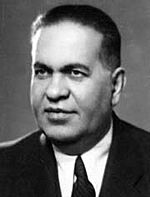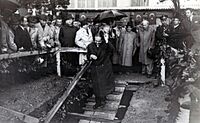Lütfi Kırdar facts for kids
Quick facts for kids
Lütfi Kırdar
|
|
|---|---|
 |
|
| Minister of Health and Social Security | |
| In office November 26, 1957 – May 27, 1960 |
|
| Prime Minister | Adnan Menderes |
| Preceded by | Nafiz Körez |
| Succeeded by | Nusret Karasu |
| Ambassador of Turkey to Sweden | |
| In office 1949–1949 |
|
| President | İsmet İnönü |
| Governor and Mayor of Istanbul | |
| In office December 5, 1938 – October 20, 1949 |
|
| Preceded by | Muhittin Üstündağ |
| Succeeded by | Fahrettin Kerim Gökay |
| Governor of Manisa | |
| In office 1936–1938 |
|
| Preceded by | Murat Germen |
| Succeeded by | Osman Şahinbaş |
| Personal details | |
| Born |
Mehmet Lütfi Kırdar
March 15, 1887 Kirkuk, Ottoman Empire |
| Died | February 17, 1961 (aged 73) Yassıada, Istanbul, Turkey |
| Citizenship | Turkish |
| Political party | Republican People's Party (1935–1951) Democrat Party (1951–1960) |
| Children | 2 |
| Alma mater | Istanbul University |
Mehmet Lütfi Kırdar (born March 15, 1887 – died February 17, 1961) was an important person in Turkish history. He was a doctor, a public servant, and a politician. He is best known for being the Governor and Mayor of Istanbul for many years.
Contents
Lütfi Kırdar's Early Life and Career
Lütfi Kırdar was born in 1887 in Kirkuk, which was part of the Ottoman Empire at that time. He came from a well-known family. After finishing school in his hometown and Baghdad, he moved to Istanbul in 1908 to study medicine at Istanbul University.
Serving His Country as a Doctor
Lütfi Kırdar paused his studies to join the army during the Balkan Wars (1912–1913). After the war, he went back to university and became a doctor in 1917. He started working in Najaf, which is now in Iraq. He joined the army again during World War I (1914-1918).
After World War I, he worked for the Turkish Red Crescent, which helps people in need. He met Mustafa Kemal Atatürk, a very important leader, and then joined the Turkish War of Independence (1919–1923). He led the military medical service during this war. For his brave work, he received the Medal of Independence.
Becoming an Eye Doctor
After Turkey became a republic in 1923, Lütfi Kırdar traveled to Vienna, Austria, and Munich, Germany, to study ophthalmology, which is the study of eye health. When he returned to Turkey in 1924, he became the Director of Health in Izmir. In 1933, he worked as an eye doctor at the State Hospital in Izmir.
Lütfi Kırdar's Political Journey
Lütfi Kırdar began his political career in 1935 when he was elected as a representative for Kütahya. He was part of the Republican People's Party. In 1936, he became the Governor of Manisa Province.
Governor and Mayor of Istanbul
On December 5, 1938, Lütfi Kırdar became the Governor and Mayor of Istanbul Province. He held this important position for twelve years, until October 20, 1949. During his time as mayor, many important buildings and places were built in Istanbul.
New Buildings and Places in Istanbul
Some of the famous places built during his time include the Sport and Exhibition Center, which is now called the Istanbul Lütfi Kırdar Convention and Exhibition Center. The Cemil Topuzlu Open-Air Theatre and the Mithat Pasha Stadium (now BJK İnönü Stadium) were also built. He also helped create Taksim Square and Atatürk Boulevard, a major road connecting the Golden Horn with Aksaray.
Later Political Roles
In 1949, Lütfi Kırdar briefly served as the Ambassador to Stockholm, Sweden. Later that year, he was elected as a representative for Manisa again. However, he lost his seat in the next general election in 1950.
He then joined the Democrat Party. He was re-elected as a representative for Istanbul in 1954 and again in 1957.
Minister of Health
On November 26, 1957, Prime Minister Adnan Menderes chose Lütfi Kırdar to be the Minister of Health and Social Security. He worked in this role until May 27, 1960. At that time, the military took over the government in an event known as the 1960 Turkish coup d'état.
Lütfi Kırdar, along with other government ministers, was arrested. He was taken to Yassıada, an island in the Marmara Sea, for a military trial. Sadly, he passed away from a heart attack during his defense in court on February 17, 1961. He was buried two days later at the Zincirlikuyu Cemetery. He had two sons, Erdem and Üner.


